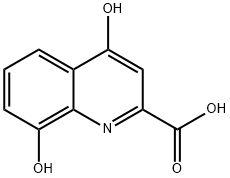XANTHURENIC ACID
Synonym(s):4,8-Dihydroxyquinaldic acid;4,8-Dihydroxyquinoline-2-carboxylic acid
- CAS NO.:59-00-7
- Empirical Formula: C10H7NO4
- Molecular Weight: 205.17
- MDL number: MFCD00006754
- EINECS: 200-410-1
- SAFETY DATA SHEET (SDS)
- Update Date: 2025-12-26 16:58:18

What is XANTHURENIC ACID?
Chemical properties
ochre powder
The Uses of XANTHURENIC ACID
Xanthurenic acid can be used as a substrate for the synthesis of:
- Silica-gel functionalized xanthurenic acid (4, 8-dihydroxyquinoline-2-carboxylic acid) as an adsorbent for metal ions.
- N, N′-bis-((8-hydroxy-7-quinolinyl)methyl)-1,10-diaza-18-crown-6 ethers as fluorescent sensors of magnesium in living cells via one-pot Mannich reaction.
- Poly-xanthurenic acid (poly-Xa) for biosensing applications.
The Uses of XANTHURENIC ACID
Excreted by pyridoxine-deficient animals after the ingestion of tryptophan.
The Uses of XANTHURENIC ACID
caspase activator, guanylyl cyclase stimulant
What are the applications of Application
Xanthurenic acid is a potent activator of group II mGluRs
Definition
ChEBI: A quinolinemonocarboxylic acid that is quinoline-2-carboxylic acid substituted by hydroxy groups at C-4 and C-8.
Storage
Room temperature
Purification Methods
It is precipitated by the addition of 2N formic acid to its solution in hot 2M ammonia (charcoal). The solid is filtered off, dried in a vacuum at ~80o in the dark. UV (H2O) has nm ( M-1cm-1): 243 (30,000) and 342 (6,500). The methyl ester has m 262o (from MeOH). It forms Cu2+, Zn2+, Fe2+ and Fe3+ salts. [Beilstein 22 III/IV 2513.]
Properties of XANTHURENIC ACID
| Melting point: | 297-298 °C (dec.)(lit.) |
| Boiling point: | 343.83°C (rough estimate) |
| Density | 1.3849 (rough estimate) |
| refractive index | 1.5600 (estimate) |
| storage temp. | Sealed in dry,2-8°C |
| solubility | DMSO (Slightly, Heated), Water (Slightly, Heated) |
| form | Powder |
| pka | 1.20±0.30(Predicted) |
| color | Ochre |
| Merck | 14,10068 |
| BRN | 185954 |
| CAS DataBase Reference | 59-00-7(CAS DataBase Reference) |
Safety information for XANTHURENIC ACID
| Signal word | Warning |
| Pictogram(s) |
 Exclamation Mark Irritant GHS07 |
| GHS Hazard Statements |
H315:Skin corrosion/irritation H319:Serious eye damage/eye irritation |
| Precautionary Statement Codes |
P264:Wash hands thoroughly after handling. P264:Wash skin thouroughly after handling. P280:Wear protective gloves/protective clothing/eye protection/face protection. |
Computed Descriptors for XANTHURENIC ACID
New Products
4,4-Difluoropiperidine hydrochloride tert-butyl 9-methoxy-3-azaspiro[5.5]undecane-3-carboxylate Indole Methyl Resin N-Isopropylurea N,N-Dicyclohexylcarbodiimide(DCC) MELDRUMS ACID 5-METHYLISOXAZOLE-4-CARBOXYLIC ACID Magnessium Bis glycinate Zinc ascorbate 1-bromo-2-butyne 2-acetamidophenol 9(10H)-anthracenone Erythrosin B, 4-Piperidinopiperidine 2-((4-morpholinophenylamino) (methylthio) methylene) malononitrile 2,4-dihydroxybenzaldehyde 3-(4-morpholinophenylamino)-5-amino-1H-pyrazole-4-carbonitrile Methyl 2-methylquinoline-6-carboxylate 2,6-dichloro-4-nitropyridine 4-Bromo-2-chlorobenzonitrile 2-(benzylamino)acetic acid hydrochloride 4-(tert-Butoxycarbonylamino)but- 2-ynoic acid 3,4-dihydro-2H-benzo[b][1,4]dioxepine 1-Phenyl-1-cycloprppanecarboxylicacidRelated products of tetrahydrofuran








You may like
-
 Xanthurenic Acid CAS 59-00-7View Details
Xanthurenic Acid CAS 59-00-7View Details
59-00-7 -
 Xanthurenic acid CAS 59-00-7View Details
Xanthurenic acid CAS 59-00-7View Details
59-00-7 -
 Xanthurenic AcidView Details
Xanthurenic AcidView Details
59-00-7 -
 3-(4-amino-1-oxoisoindolin-2-yl)-1-methylpiperidine-2,6-dione 98%View Details
3-(4-amino-1-oxoisoindolin-2-yl)-1-methylpiperidine-2,6-dione 98%View Details -
 20677-73-0 (2,2-diethoxyethyl)methylamine 98%View Details
20677-73-0 (2,2-diethoxyethyl)methylamine 98%View Details
20677-73-0 -
 3-(4-(hydroxyamino)-1-oxoisoindolin-2-yl)piperidine-2,6-dione 98%View Details
3-(4-(hydroxyamino)-1-oxoisoindolin-2-yl)piperidine-2,6-dione 98%View Details -
 57381-49-4 2-bromo-4-chlorobenzonitrile 98%View Details
57381-49-4 2-bromo-4-chlorobenzonitrile 98%View Details
57381-49-4 -
 4,6-dichloropyrimidine-5-carbaldehyde 98%View Details
4,6-dichloropyrimidine-5-carbaldehyde 98%View Details
5305-40-8
Statement: All products displayed on this website are only used for non medical purposes such as industrial applications or scientific research, and cannot be used for clinical diagnosis or treatment of humans or animals. They are not medicinal or edible.
